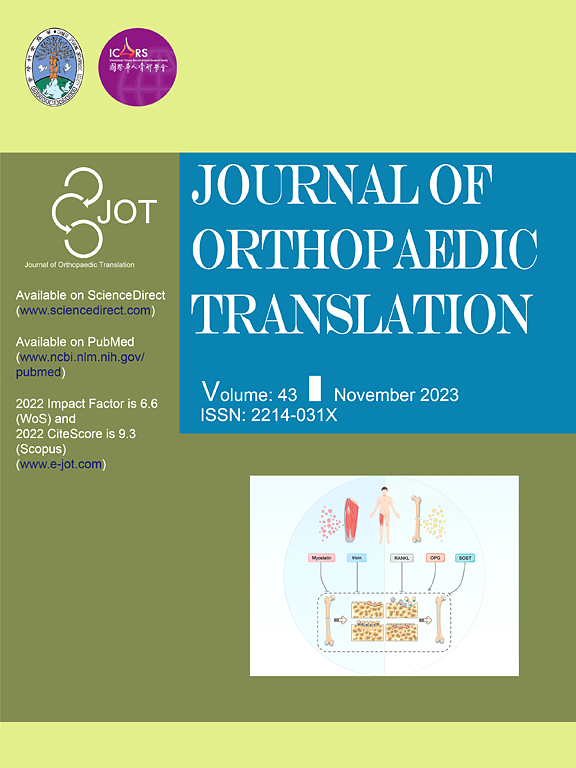双相矿化胶原/聚己内酯支架在大负荷骨缺损修复中的应用:羊模型研究
IF 5.9
1区 医学
Q1 ORTHOPEDICS
引用次数: 0
摘要
目的研究bMC/PCL复合支架在绵羊模型下修复大负荷骨缺损,特别是股骨骨缺损的效果。方法采用多孔矿化胶原/聚己内酯(pMC/PCL)与致密矿化胶原/聚己内酯(cMC/PCL)复合制备bMC/PCL支架。采用扫描电镜观察支架的微观结构,并通过压缩测试评估其力学性能。选取20只母羊制作20 mm股骨缺损模型,分为空白组(未植入材料)和实验组(植入bMC/PCL支架),每组10只。术后1个月、3个月和6个月,采用Lane-Sandhu评分和视觉模拟评分法对跛行进行骨愈合和下肢功能恢复评估。此外,通过x线,Micro-CT和组织学分析分析骨修复进展。结果与空白组比较,bMC/PCL支架组骨缺损修复效果明显改善。术后3个月和6个月,x线、Micro-CT扫描和组织学染色显示支架整合稳定,新骨逐渐形成。实验组在第3个月和第6个月的Lane-Sandhu评分分别为3.60±0.548和4.00±0.707,而空白组出现钢板/螺钉断裂导致固定失败,评分为1,说明实验组骨愈合较好。实验组3个月和6个月跛行评分分别为2.71±0.97和1.48±0.86,显著低于空白组(p <;0.0001和p = 0.0002)。显微ct分析显示,术后3、6个月骨体积与组织体积比由28.07±9.22%增加至62.02±11.82%,骨密度由0.392±0.032 g/cm3增加至0.583±0.125 g/cm3,骨小梁厚度由0.690±0.224 mm增加至1.049±0.089 mm,骨小梁间距由2.766±1.183 mm减少至0.501±0.268 mm。结论本研究评价了bMC/PCL支架修复大负荷骨缺损的效果。bMC/PCL支架具有良好的生物活性和力学性能,具有良好的临床应用前景。未来的研究应进一步在更广泛的动物模型中验证这些支架的安全性和有效性,以支持其临床应用。bMC/PCL支架为大股骨缺损提供了一种有希望的解决方案,在骨科和创伤手术中具有潜在的临床应用前景。bMC/PCL支架在临床中的应用有望显著推进大型骨缺损尤其是负重骨缺损的治疗。本研究表明,bMC/PCL支架对大型负重骨缺损的修复和功能恢复有显著影响,在骨科和创伤护理方面具有潜在的应用前景。具体来说,该材料在承重骨中的支撑作用为其在承重骨缺损修复中的应用提供了新的可能性。此外,bMC/PCL支架的骨愈合性能使其成为治疗各种骨缺损的理想候选材料,具有广阔的临床应用前景。需要进一步的临床试验来确认它们在人类患者中的安全性和有效性。本文章由计算机程序翻译,如有差异,请以英文原文为准。

Application of biphasic mineralized collagen/polycaprolactone scaffolds in the repair of large load-bearing bone defects: A study in a sheep model
Objective
This study aims to evaluate the efficacy of biphasic mineralized collagen/polycaprolactone (bMC/PCL) scaffolds in repairing large load-bearing bone defects, particularly femoral defects, using a sheep model.
Methods
The bMC/PCL scaffolds were prepared by combining porous mineralized collagen/polycaprolactone (pMC/PCL) with compact mineralized collagen/polycaprolactone (cMC/PCL). The scaffolds were characterized using scanning electron microscopy to observe the microstructure and compression testing to assess mechanical properties. Twenty female sheep were selected to create a 20 mm femoral defect model, divided into a blank group (no material implanted) and an experimental group (bMC/PCL scaffolds implanted), with 10 sheep in each group. Bone healing and lower limb functional recovery were assessed at 1 month, 3 months, and 6 months postoperatively using Lane-Sandhu scores and visual analog scale scores for lameness. Additionally, bone repair progress was analyzed through X-ray, Micro-CT, and histological analyses.
Results
Compared with the blank group, the bMC/PCL scaffold group showed significant improvement in bone defect repair. At 3 and 6 months postoperatively, X-ray, Micro-CT scans, and histological staining indicated stable scaffold integration and gradual new bone formation. The Lane-Sandhu scores in the experimental group were 3.60 ± 0.548 and 4.00 ± 0.707 at 3 and 6 months, respectively, whereas the blank group experienced plate/screw breakage leading to fixation failure, with scores of 1, indicating better bone healing in the experimental group. The lameness scores in the experimental group were 2.71 ± 0.97 and 1.48 ± 0.86 at 3 and 6 months, respectively, significantly lower than those in the blank group (p < 0.0001 and p = 0.0002). Micro-CT analysis showed that bone volume to tissue volume ratio increased from 28.07 ± 9.22 % to 62.02 ± 11.82 %, bone mineral density increased from 0.392 ± 0.032 g/cm3 to 0.583 ± 0.125 g/cm3, trabecular thickness increased from 0.690 ± 0.224 mm to 1.049 ± 0.089 mm, and trabecular separation decreased from 2.766 ± 1.183 mm to 0.501 ± 0.268 mm at 3 and 6 months postoperatively.
Conclusion
This study evaluated the efficacy of bMC/PCL scaffolds in repairing large load-bearing bone defects. The bMC/PCL scaffolds demonstrated good bioactivity and mechanical properties, indicating promising clinical application prospects. Future studies should further verify the safety and efficacy of these scaffolds in a wider range of animal models to support their clinical application.
Significance statement
The bMC/PCL scaffolds offer a promising solution for large femoral bone defects, with potential for clinical use in orthopedic and trauma surgeries.
The translational potential of this article
The application of bMC/PCL scaffolds in clinical practice is expected to significantly advance the treatment of large bone defects, particularly weight-bearing bone defects. The study shows that bMC/PCL scaffolds have a significant impact on the repair of large weight-bearing bone defects and functional recovery, indicating their potential for application in orthopedics and trauma care. Specifically, the material's supportive role in weight-bearing bones offers new possibilities for its use in the repair of weight-bearing bone defects. Furthermore, the performance of bMC/PCL scaffolds in bone healing makes them an ideal candidate material for treating various bone defects, with broad clinical application prospects. Further clinical trials are necessary to confirm their safety and efficacy in human patients.
求助全文
通过发布文献求助,成功后即可免费获取论文全文。
去求助
来源期刊

Journal of Orthopaedic Translation
Medicine-Orthopedics and Sports Medicine
CiteScore
11.80
自引率
13.60%
发文量
91
审稿时长
29 days
期刊介绍:
The Journal of Orthopaedic Translation (JOT) is the official peer-reviewed, open access journal of the Chinese Speaking Orthopaedic Society (CSOS) and the International Chinese Musculoskeletal Research Society (ICMRS). It is published quarterly, in January, April, July and October, by Elsevier.
 求助内容:
求助内容: 应助结果提醒方式:
应助结果提醒方式:


